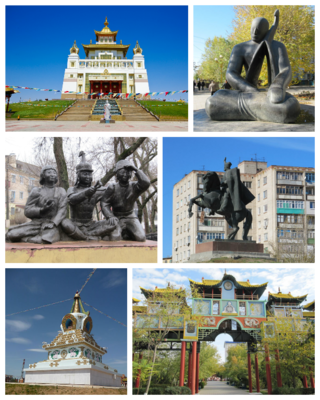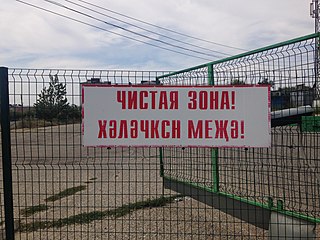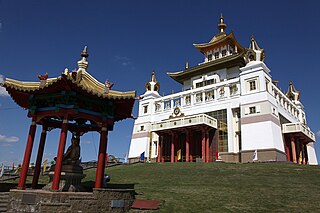Related Research Articles

Kalmyks are the only Mongolic-speaking people living in Europe, residing in the easternmost part of the European Plain.

Oirats or Oirds, formerly known as Eluts and Eleuths, are the westernmost group of the Mongols, whose ancestral home is in the Altai region of Siberia, Xinjiang and western Mongolia.

Elista is the capital city of the Republic of Kalmykia, Russia.

Kalmyk Oirat, commonly known as the Kalmyk language, is a variety of the Mongolian language, natively spoken by the Kalmyk people of Kalmykia, a federal subject of Russia. In Russia, it is the standard form of the Oirat Mongolian, which belongs to the Mongolic language family. The Kalmyk people of the Northwest Caspian Sea of Russia claim descent from the Oirats from Eurasia, who have also historically settled in Mongolia and Northwest China. According to UNESCO, the language is "definitely endangered". According to the Russian census of 2021, there are 110,000 speakers out of an ethnic population consisting of 178,000 people.

Deportation of the Kalmyks, codename Operation Ulusy was the Soviet deportation of more than 93,000 people of Kalmyk nationality, and non-Kalmyk women with Kalmyk husbands, on 28–31 December 1943. Families and individuals were forcibly relocated in cattle wagons to special settlements for forced labor in Siberia. Kalmyk women married to non-Kalmyk men were exempted from the deportations. The government's official reason for the deportation was an accusation of Axis collaboration during World War II based on the approximately 5,000 Kalmyks who fought in the Nazi-affiliated Kalmykian Cavalry Corps. The government refused to acknowledge that more than 23,000 Kalmyks served in the Red Army and fought against Axis forces at the same time.

Kalmykia, officially the Republic of Kalmykia, is a republic of Russia, located in the Volga region of Southern Russia. The republic is part of the Southern Federal District, and borders Dagestan to the south and Stavropol Krai to the southwest; Volgograd Oblast to the northwest and north and Astrakhan Oblast to the north and east; Rostov Oblast to the west and the Caspian Sea to the east. Through the Caspian Depression, the Kuma river forms Kalmykia's natural border with Dagestan. Kalmykia is the only polity within Europe where the Dharmic religion of Tibetan Buddhism is the predominant religion.

The Khoshut are one of the four major tribes of the Oirat people. They established the Khoshut Khanate in the area of Qinghai in 1642–1717.

The Kalmyks are the only Mongolic-speaking people of Europe whose national religion is Buddhism. In 2016, 53.4% of the population surveyed identified themselves as Tibetan Buddhists. They live in Kalmykia, a federal subject of Russia in the southwest. Kalmykia borders Dagestan to the south, Stavropol Krai to the southwest, Rostov Oblast to the west, Volgograd Oblast to the northwest, and Astrakhan Oblast to the east. The Caspian Sea borders Kalmykia to the southeast.

Oirat is a Mongolic language spoken by the descendants of Oirat Mongols, now forming parts of Mongols in China, Kalmyks in Russia and Mongolians. Largely mutually intelligible to other core Central Mongolic languages, scholars differ as to whether they regard Oirat as a distinct language or a major dialect of the Mongolian language. Oirat-speaking areas are scattered across the far west of Mongolia, the northwest of China and Russia's Caspian coast, where its major variety is Kalmyk. In China, it is spoken mainly in Xinjiang, but also among the Deed Mongol of Qinghai and Subei County in Gansu.

The Clear Script is an alphabet created in 1648 by the Oirat Buddhist monk Zaya Pandita for the Oirat language. It was developed on the basis of the Mongolian script with the goal of distinguishing all sounds in the spoken language, and to make it easier to transcribe Sanskrit and the Tibetic languages.

The flag of Kalmykia consists of a yellow field with a sky blue circle in the center containing a lotus. The yellow stands for the sun, the people and the religious faith of the nation. The blue represents the sky, eternity, and steadiness. The lotus is a symbol of purity, spiritual rebirth and happiness. Its five upper petals represent the continents and the lower four stand for the quarters of the globe. Together, they symbolize the will of the Kalmyks to live in friendship and to cooperate with all the nations of the world.
The Kalmykian Cavalry Corps was a unit of about 5,000 ethnic Kalmyk volunteers who chose to join the German Army in 1942 rather than remain in Kalmykia as German forces retreated before the Red Army. Stalin subsequently declared the Kalmyk population as a whole to be German collaborators in 1943 and ordered mass deportations to Siberia suffering great loss of life.
Kalmyk Americans are Americans of Kalmyk Mongolian ancestry.

Erdne-Basan Ombadykow, also known as Telo Tulku Rinpoche, is the Tibetan Buddhist spiritual leader of the Kalmyk people. He received his formal training as a bhikṣu in India and was recognized by the 14th Dalai Lama as the current reincarnation of mahasiddha Tilopa.

Kalmyk State University is the oldest and largest university in Kalmykia. Since 2011 it is called Federal State Budget Educational Establishment of Higher Professional Education. The university was established in 1970, and now it has more than 8,000 students, studying at 7 Departments and 1 institute:

The Kalmyk Khanate was an Oirat Mongol khanate on the Eurasian steppe. It extended over modern Kalmykia and surrounding areas in the North Caucasus, including Stavropol and Astrakhan. During their independence, the Kalmyks both raided and allied with Russia in turn, engaging in numerous military expeditions against the Crimean Tatars, the Ottoman Empire, neighboring Muslim tribes, and the highlanders of the North Caucasus. The Khanate was annexed by the Russian Empire in 1771.
The Sart Kalmyks are an ethnic group of the Oirats, who live in Issyk Kul Province, Kyrgyzstan. Their population is estimated to be c. 12,000. They are descendants of the Ööled tribes, who moved to the territory of the Russian Empire after the failure of the Dungan revolt, some part inhabited the area during the rule of the Zunghar Khanate. They used to speak Sart Kalmyk, a dialect of the Oirat language, but have largely switched to the Kyrgyz language by now. As a result of their long co-inhabitance with Kyrgyz people, they have largely incorporated into the Kyrgyz nation, though some Kyrgyz still consider them to be distinct. Today the majority of Sart Kalmyks also identify themselves as Kyrgyz, or as "almost Kyrgyz". They belong to the Muslim faith.
Anti-Mongolianism, also called anti-Mongolian sentiment, has been prevalent throughout history, often perceiving the Mongols to be barbaric and uncivilized people with a lack of intelligence or civilized culture.
The Congress of the Oirat-Kalmyk People, also known as the Chuulhn in Kalmyk Oirat Mongolian, is an registered worldwide organization claiming to represent the all Kalmyk people or broadly people of Russia's Republic of Kalmykia.
Territorial disputes between Kalmykia and Astrakhan Oblast, two federal subjects in southwestern Russia, refer to a number of land claims expressed by Kalmyk politicians and activists since the 1950s to this day. They have been the subject of federal lawsuits and led to small-scale real-life conflicts on several occasions, such as a nomadic herder from Kalmykia being arrested and his cattle confiscated by Astrakhan park rangers after he entered the land they considered theirs despite the borders shown in government-approved maps.
References
- 1 2 "Kalmyk Activist Who Fled Russia Unable To Enter Mongolia Due To Expired Passport". Radio Free Europe . Retrieved 14 January 2025.
- ↑ "Russian national liberation movements at Washington Summit endorse armed resistance against Kremlin". Ukrainian World Congress . Retrieved 14 January 2025.
- ↑ Byurchiev, Badma. "Court fines Boromangnaev for insulting Putin". Caucasian Knot . Retrieved 15 January 2025.
- ↑ "Yabloko chairman in Kalmykia prosecuted for insulting Putin's regime". caucasuswatch. Retrieved 15 January 2025.
- ↑ Byurchiev, Badma. "Activists state persecutions after congress of Oirat-Kalmyk nationals in Elista". Caucasian Knot . Retrieved 14 January 2025.
- ↑ "Kalmyk activist Boromangnaev states threat of deportation from Mongolia". Caucasian Knot . Retrieved 15 January 2025.
- ↑ "After detention in Mongolia, activist Batyr Boromangnaev flies to USA". Caucasian Knot . Retrieved 15 January 2025.
- ↑ "Kalmyk Activist With Expired Russian Passport On His Way To U.S. After Mongolia Refused Entry". Radio Free Europe/Radio Liberty . Retrieved 15 January 2025.